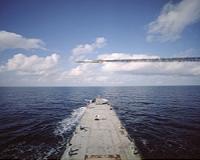| . |  |
. |
ONR Corporate Strategic Communications Arlington VA (SPX) Jul 20, 2010 The Low-Cost Imaging Terminal Seeker (LCITS), an Office of Naval Research (ONR)-sponsored technology, could soon give the U.S. Navy and coalition military ships an upper hand in swiftly defeating multiaxis attacks by small swarming boats. Managed by ONR's Naval Air Warfare and Weapons Department as a Future Naval Capability (FNC), LCITS equips the unguided Hydra-70 rocket with a low-cost imaging infrared guidance solution to more accurately strike an intended target. Steve Smolinski, Office of Transition FNC director, explained the importance of the FNC program to fulfilling naval missions such as LCITS. "The FNC program represents the requirements-driven, delivery-oriented portion of the Navy's science and technology investment," Smolinski said. "FNC enabling capabilities draw upon technologies that can be developed, matured and delivered to acquisition programs within a three- to five-year period." The seeker is composed of three main subsystems: a targeting integration system aboard the helicopter, a digital smart launcher and the guided imaging rocket. The helicopter uses its targeting system to lock onto and track the target's position and velocity, and transfers the information to the rocket launcher prior to weapon release. Once locked onto the target, the weapon follows the LCITS commands to the target. From a pilot's perspective, the entire process can be handled in a matter of seconds, increasing the number of targets that can be engaged in a short amount of time. LCITS can also engage targets in a 120-degree cone centered off the nose of the helicopter at ranges up to 7 kilometers. Howard McCauley, LCITS principal investigator in the China Lake Naval Air Warfare Center's Emergent Weapons Division, touts the speed by which the system operates. "The key to survivability while effectively engaging and defeating the fast inshore attack craft threat is the target engagement timeline," McCauley said. "You must be able to very rapidly engage and defeat each target. The technology we've developed will provide this increased capability." In a demonstration earlier this year, an LCITS-equipped AH-1 Cobra helicopter targeted and fired a rocket against a maneuvering unmanned small boat at a test range off the coast of California. The pivotal test firing highlighted not only LCITS' ability to strike high-speed mobile surface targets, but marked the successful conclusion of the program, opening the door for its transition to the fleet. The Republic of Korea teamed with the United States in this co-development between the two countries, helping to improve the aerodynamic performance of the rocket system and lower the overall design cost. Dr. Seung-Ki Ahn, project manager at the Agency for Defense Development for the Republic of Korea cites multinational collaboration for the success of the test launch. "This was a great moment to exhibit how the potential of a true team effort between the Republic of Korea and the U.S. can very effectively expedite the fielding of a low-cost precision guided weapon,'' Ahn said. The seeker now moves forward to the Medusa Joint Capability Technology Demonstration phase. Started in 2009, the Medusa ensures that a military utility assessment will be completed on the LCITS, which will lead the way to a naval acquisition program.
Share This Article With Planet Earth
Related Links Office of Naval Research (ONR) The latest in Military Technology for the 21st century at SpaceWar.com
 First High-Altitude Coyote Supersonic Target Vehicle Launched
First High-Altitude Coyote Supersonic Target Vehicle LaunchedDulles VA (SPX) Jul 16, 2010 Orbital Sciences Corporation has announced that it successfully launched the "High Diver" Coyote supersonic target vehicle from San Nicolas Island, California, validating its suitability for future high-altitude naval threat simulations and anti-missile response system tests. The Coyote High Diver (or Coyote HD) vehicle was rail-launched from San Nicolas Island at about 9:00 a.m. PDT on 8 ... read more |
|
| The content herein, unless otherwise known to be public domain, are Copyright 1995-2010 - SpaceDaily. AFP and UPI Wire Stories are copyright Agence France-Presse and United Press International. ESA Portal Reports are copyright European Space Agency. All NASA sourced material is public domain. Additional copyrights may apply in whole or part to other bona fide parties. Advertising does not imply endorsement,agreement or approval of any opinions, statements or information provided by SpaceDaily on any Web page published or hosted by SpaceDaily. Privacy Statement |